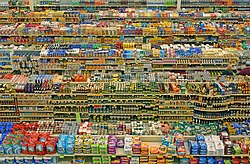**Food Production and Processing**:
– Agriculture involves producing food, feeding products, and fiber from plants and livestock.
– Aquaculture cultivates aquatic organisms like fish and mollusks in controlled environments.
– Fishing harvests wild aquatic species from oceans, rivers, and lakes.
– Food processing transforms raw ingredients into marketable food products using methods like one-off production, batch production, and mass production.
– Global agriculture production accounts for 14-28% of greenhouse gas emissions.
**Industry Influence and Corporate Influence**:
– The food industry heavily influences consumerism and organizations like The American Academy of Family Physicians receive donations from food industry companies.
– Criticisms include conflicts of interest and prioritizing financial gains.
– The World Bank and IMF shape the food industry post-World War II by stabilizing economies and influencing policies and practices in global food production.
**Policy and Regulation**:
– Scientists emphasize the need to reduce emissions from the global food system for achieving climate goals.
– Regulations exist to protect consumers and balance economic orientation with public interests for food quality, safety, and environmental protection.
– Reports suggest a significant increase in emissions by 2050 due to population growth and changing consumption patterns.
**Proactive Guidance and Wholesale/Distribution**:
– Researchers highlight policy-dependent mechanisms for food production, including reducing meat production and food waste.
– Efficient distribution centers are crucial for the uninterrupted flow of products in the food industry.
– Global coordination and rapid action are necessary for effective policy implementation in the food industry.
**Retail and Food Industry Technologies**:
– Supermarkets have become the primary retail element of the food industry, selling raw products for home cooking.
– Technologies like robotics, automation, blockchain, nanotechnology, and artificial intelligence optimize processes and improve the quality and safety of food products.
– Urbanization has led to a disconnect between food production and buying, with online grocery stores and digital technologies transforming food retail.
The food industry is a complex, global network of diverse businesses that supplies most of the food consumed by the world's population. The food industry today has become highly diversified, with manufacturing ranging from small, traditional, family-run activities that are highly labour-intensive, to large, capital-intensive and highly mechanized industrial processes. Many food industries depend almost entirely on local agriculture, animal farms, produce, and/or fishing.



It is challenging to find an inclusive way to cover all aspects of food production and sale. The UK Food Standards Agency describes it as "the whole food industry – from farming and food production, packaging and distribution, to retail and catering". The Economic Research Service of the USDA uses the term food system to describe the same thing, stating: "The U.S. food system is a complex network of farmers and the industries that link to them. Those links include makers of farm equipment and chemicals as well as firms that provide services to agribusinesses, such as providers of transportation and financial services. The system also includes the food marketing industries that link farms to consumers, and which include food and fiber processors, wholesalers, retailers, and foodservice establishments." The food industry includes:
- Agriculture: raising crops, livestock, and seafood. Agricultural economics.
- Manufacturing: agrichemicals, agricultural construction, farm machinery and supplies, seed, etc.
- Food processing: preparation of fresh products for market, and manufacture of prepared food products
- Marketing: promotion of generic products (e.g., milk board), new products, advertising, marketing campaigns, packaging, public relations, etc.
- Wholesale and food distribution: logistics, transportation, warehousing
- Foodservice (which includes catering)
- Grocery, farmers' markets, public markets and other retailing
- Regulation: local, regional, national, and international rules and regulations for food production and sale, including food quality, food security, food safety, marketing/advertising, and industry lobbying activities
- Education: academic, consultancy, vocational
- Research and development: food science, food microbiology, food technology, food chemistry, and food engineering
- Financial services: credit, insurance
Areas of research such as food grading, food preservation, food rheology, food storage directly deal with the quality and maintenance of quality overlapping many of the above processes.
Only subsistence farmers, those who survive on what they grow, and hunter-gatherers can be considered outside the scope of the modern food industry.
The dominant companies in the food industry have sometimes been referred to as Big Food, a term coined by the writer Neil Hamilton.
